Searching for "writing"
Library 2.019 virtual mini-conference, “Shaping the Future of Libraries with Instructional Design
Wednesday, March 13th, from 12:00 – 3:00 pm US Pacific Daylight Time (click https://www.timeanddate.com/worldclock/fixedtime.html?msg=Library+2.019+ID&iso=20190313T12&p1=283&ah=3 to see in your local time zone).
Here are the links to the recordings of the sessions:
https://www.library20.com/page/recordings-id (you must be logged in)
This is a free event, thanks to our founding conference sponsor: School of Information at San José State University.
ATTENDING: We will send links for attending the conference a day or two before the event.
If you have friends or colleagues that wish to attend, this is a free event and we encourage you to share our information widely. However, please send them to the conference registration page (https://www.library20.com/instructionaldesign) rather than giving them the above link directly as it will allow us to track participation.
https://www.library20.com/instructionaldesign
https://www.library20.com/forum/categories/library-2-019-instructional-design-accepted-submissions/listForCategory
#library2019 #libraryid

Dana Bryant
Sandy Hirsch, SJSU School of Information.
Steven Bell, John Shank – integrating ID into practice. blended librarianship.
critical mass of librarians doing ID and libraries hiring IDs.
Michael Flierl
Assistant Professor of Library Science, Purdue University
Dana Bryant
Lead Instructional Technologist for Academic Technology Services, Woodruff Library, at Emory University
Lindsay O’Neill
Faculty, California State University, Fullerton’s Master of Science in Instructional Design and Technology Program
Steven J. Bell (moderator)
Associate University Librarian for Research and Instructional Services at Temple University
https://www.library20.com/page/library-2-0-schedule-gmt-4
What is ID: ID create an environment conductive to students’ success. Thoughtful and applied design. Making faculty and instructors’ life easier. Allow faculty to do what they do best.
Lindsey: solving the instructional problem with the tools at hand.
go-to ed tech? What is the hot tech right now?
Lindsey: H5P (open source) CC – licensed, Moodle, WordPress, build online tutorials for free (Isolde), Norway, well based, VR tours. Will H5P become paid? Michael: cell phones Dana: Emory VoiceThread. From the chat: Articulate365 (pricy), Kahoot, Peardeck, Yellowdig, vidgrid, Adobe Spark, Adobe POst, padlet, Groupme instead of Canvas, Vyond, Coggle, wakelet, Phinx
Suggestions for librarians who want to build ID skills. Dana: connect with the regional community if no ID on campus. Community of practice. Using ID tools, speakers outside of campus. Lindsey: teaching myself what is most interesting to me. what technologies are important. Find a learning community. Michael: repeat the others
keep up to date on ID theory and practices: Dana – ELI, OLC (Online Learning Consortium). ELearning Heroes. Lindsay: corporate word. Michael: POD
the one-shot instruction: what is the approach (q/n from the chat); Dana – ID as a services. person dedicated following up with people requested either ID class or training, open the line of communication. summative evaluation type of activity since we are failing to evaluate how well students absorbed the information. LIndsey: one-shot for basics (e.g. freshman), build scaffold program, reserved the one shot for meeting with librarians, for hands-on. Michael: work with faculty member and rewrite a program, build assessment rather then only deliver
areas of impact: subject matter librarians, working with faculty to use of the library resources, new faculty drawn in info and if not follow up, Canvas support. Michael: librarians and ID working directly with faculty rewriting their curricula, measure it, demonstrating library need, 3000 students – correlation. document the lib contribution to student learning directly, the teaching-learning culture change. using info and data in more authentic ways. Lindsey: disconnect the way librarian teach vs faculty teach. Coordination scaffolding.
q/n from the chat. easily. how can non ID librarian can easily implement ID type:
Lindsey: new to ID? Google. Jargon and Acronyms. re framing how you see ed technology. technology as something to get the job done. no need to get fancy.
Dana: same as Lindsey. But also learning theories and learning outcomes. From ID perspective: what they will come out with by the end of the session. action words.
Michael: mindset. what students want to learn, before what I will teach. backward design – understanding by design. UDL. Grab a friend and talk through.
Tara
ed tech is not getting job done:
clickers for attendance is horrible idea.
from the chat:
Dee Fink’s Taxonomy of Significant Learning1
https://www.byui.edu/outcomes-and-assessment-old/the-basics/step-1-articulate-outcomes/dee-finks-taxonomy-of-significant-learning
https://www.alt.ac.uk/
Association of Talent Development
Christy Tucker’s blog – Experiencing E-Learning
https://www.issotl.com/2019
https://e-learning.zeef.com/tracy.parish
https://www.lib.umich.edu/blogs/tiny-studies/using-pilot-study-test-and-assess-new-instruction-model
http://suny.edu/emtech
I had a really interesting role in grad school where we lived in the land between tech support and pedagogical / design support.
From Rajesh Kumar Das to All panelists and other attendees: (02:38 PM)
Good to hear from mike about affective learning. In this case, could you please focus what kind of technique is approprite for what, i.e. Didactic instruction, a low-complexity teaching technique such as a “Quiz Bowl”, or Jigsaw Method as high-complexity strategy, or both.
From Hailey W. to All panelists and other attendees: (02:36 PM)
As an ID librarian and the campus LMS administrator I struggle with getting them to see that other side of my role. That I’m not just “tech support”. Anyone else? Een jsut not being tech support?
From Vickie Kline to All panelists and other attendees: (02:44 PM)
As a librarian not formally trained in ID, I think a good entry point for exploring is Universal Design for Learning. We also need to pay attention to creating accessibility materials…
From Heather Quintero to All panelists and other attendees: (02:45 PM)
I always start with ADDIE… I am formally trained in ID and am an IT trainer for librarians. ADDIE is a framework for every class I make for both live and online classes. Don’t disregard ADDIE.
From Allison Rand to All panelists and other attendees: (02:47 PM)
The Wiggins and McTighe is a great book!
ADDIE Model
From Shane to All panelists and other attendees: (02:48 PM)
++SLIS open-source course on Instructional Design for Library Instruction
From Wendy to All panelists and other attendees: (02:49 PM)
Char Booth’s USER is also a very good model
http://www.modernlearning.com
https://web.mit.edu/jbelcher/www/TEALref/Crouch_Mazur.pdf
From Roberta (Robin) Sullivan to All panelists and other attendees: (02:53 PM)
@Rachel, Peggy, Shane – an open source course is available. Check out the SUNY’s Quality by Design (QbD): Strategies for Effective Teaching and Quality Course Design at: http://suny.edu/qbd This course is available as a facilitated version at least once each semester and as a self-paced non-facilitated version in Blackboard’s CourseSites. After completing the course requirements you can earn a Digital Badge to show your accomplishment.
From Naomi Toftness to All panelists and other attendees: (02:55 PM)
Just heard the terms “deliberate innovation” vs. “desperate innovation” that totally speaks to my situation with wanting to adopt the new cool tech
++++++++++++++++++++++
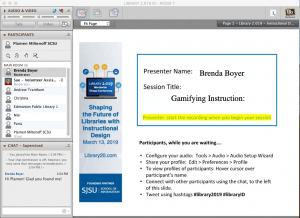 SESSION LINK – https://sas.elluminate.com/d.jnlp?sid=2008350&password=LIB2019IDPart7 — If the session link doesn’t work for you, please copy and paste into your browser.
SESSION LINK – https://sas.elluminate.com/d.jnlp?sid=2008350&password=LIB2019IDPart7 — If the session link doesn’t work for you, please copy and paste into your browser.
Session Title: Gamifying Instruction: Breakouts and Badges!
Your Name and Title: Dr. Brenda Boyer, Librarian & Instructor
Your Library, School, or Organization Name: Kutztown Sr. High School, Rutgers University
Your Twitter Handle (@name): @bsboyer
Name(s) of Co-Presenter(s): Brenda Boyer
Area of the World from Which You Will Present: Kutztown, PA
Language in Which You Will Present: English
Target Audience: Instructional Design Librarians
Short Session Description: Build engagement for your online library instruction using LMS features, Breakout boxes, and digital badges.
Session Strand (use the “tag”): {Session Strand (use the “tag”):}
Full Session Description: It’s time to amp up your library instruction! Gamifying instruction in research skills such as database usage, advanced searching, & more can increase engagement and drive independent learning for students of all ages. This session will describe how learning management system (LMS) features can be combined with digital microcredentials (i.e. badges) and breakout boxes to gamify instruction that can be otherwise deemed boring (for both the learners and the librarian!).
Link to Conference Site Session Proposal (full URL with http://): https://www.library20.com/forum/topics/gamifying-instruction-breakouts-and-badges
Other Websites / URLs Associated with Your Session:
Your Bio: Dr. Brenda Boyer is a librarian and instructional designer. She has developed online instruction for secondary learners in the Kutztown (PA) School District, as well as for graduate and professional development learners at Wilson College and Rutgers University. She designed and instructs the Rutgers graduate course, Learning Theory, Inquiry, & Instructional Design, and is a frequent presenter at AASL, Internet@Schools. She has published articles in School Library Journal, Teacher Librarian, and School Library Connection.
Email: boyer.brenda@gmail.com
notes from Brenda’s session:
are we getting the job done, is our instruction sticking, what evidence we do have?
differentiate: who is ready to do what” at what skill level? how to bring everybody up to speed?
3 elements of Digital Gamification: leverage LMS (set game levels); how digital badges are paired 3. using digital breakout boxes to push challenge, skills
each chat as prerequisite for the next. prerequisite in LMS. Each game level is module. completed with a quizz. if they pass the quiz, opens challenge.1. what is page (facts about a tool to learn about[ what the tool does, feature, etc.) 2. suppe rshort video tour (3 min max), talk about something unique 3. quick quiz (max 5 q/s from the intro page and video). pass the quiz (100 %) to unlock the challenge level. 4. challenge level. digital breakout box embedded in the LMS. breakout using Google Forms. various locks (words, letter, numbers)

Badges why?
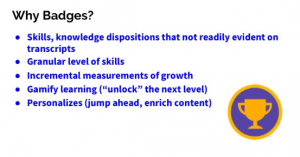
 Badgr, Credly, iDoceo
Badgr, Credly, iDoceo
Breakout Boxes

++++++++++++++++++++++
SESSION LINK – https://sas.elluminate.com/d.jnlp?sid=2008350&password=LIB2019IDPart8 — If the session link doesn’t work for you, please copy and paste into your browser.
Session Title: Improving Library Tutorials: The Multimedia Design Principles
Your Name and Title: Darlene Aguilar, Instructional Design Librarian
Your Library, School, or Organization Name: Loyola Marymount University
Your Twitter Handle (@name): @DarleneA_ID
Name(s) of Co-Presenter(s):
Area of the World from Which You Will Present: Los Angeles, CA
Language in Which You Will Present: English
Target Audience: Reference and Instruction Librarians, Instructional Designers, Tutorial developers, Academic Librarians
Short Session Description: This session will review Mayer’s (2001) Multimedia Design Principles to help improve instructional modules, tutorials, and videos.
Session Strand (use the “tag”): {Session Strand (use the “tag”):}
Full Session Description: Librarians are creating more online modules, videos, and tutorials to teach information literacy skills. Whether designing instruction online or in-person, research-based instructional methods are required and learning Mayer’s Multimedia Design Principles is the best place to start. In this session, I will review essential prior-knowledge on image types and working memory. I will then show learners how to minimize cognitive overload using these 12 principles: multimedia, spatial contiguity, temporal contiguity, coherence, modality, redundancy, individual differences, signaling, pacing, concepts first, personalization, and human voice.
Link to Conference Site Session Proposal (full URL with http://): https://www.library20.com/forum/topics/improving-library-tutorials-the-multimedia-design-principles
Other Websites / URLs Associated with Your Session: https://linkedin.com/in/darlene-aguilar/
Your Bio: Darlene Aguilar is an Instructional Design Librarian at Loyola Marymount University where she designs and develops video tutorials and online modules on information literacy and library related topics. Additionally, she provides “best practices” training in instructional design to other LMU librarians. She graduated from the University of Southern California with a Master’s in Education for Learning Design and Technology and previously worked at LAUSD for 7 years. She strives to remove learning barriers that are embedded in instruction and curriculum and make learning accessible to all learners.
Email: darlene.aguilar@lmu.edu
notes from Darlene Aguilar session: spacial contiguity, temporal contiguity. Modality: animation + narration better then animation + text, redundancy: animation and narration then animation + narration + text

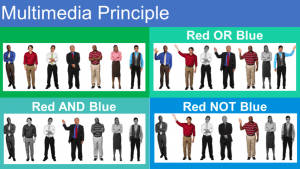
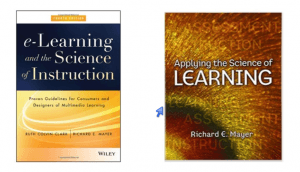
Mario Vargas Llosa: “Political correctness is the enemy of freedom”
https://elpais.com/elpais/2018/02/27/inenglish/1519736544_699462.html
Besides writing prize-winning fiction, the Nobel Laureate has fought tirelessly for civil liberties. With his new book, ‘The Call of the Tribe,’ he promotes liberal thought and pays tribute to seven authors who embrace it. We talk to him about liberalism, intellectual blindness and the dangers facing democracy today
liberalism defends some basic ideas: freedom, individualism, the rejection of collectivism and nationalism – in other words, all the ideologies or doctrines that limit or annihilate freedom within society.
Nationalism is present, but my impression is that, as with Catalonia, it’s a minority and the strength of democratic institutions is going to gradually undermine it until it’s derailed.
I wanted to be a communist. I thought communism represented the antithesis of a military dictatorship, corruption and, above all, inequality.
But the communism in Latin America was pure Stalinism, with parties subject to the Comintern in Moscow.
Fidel invited myself and a dozen other intellectuals to speak to him. We spent the whole night, 12 hours, from eight in the afternoon to eight the next morning, basically listening to him speak. It was impressive, but not very convincing.
Blindly, intellectuals have always seen democracy as a mediocre system that lacked the beauty, perfection and coherence of the big ideologies. And this blindness is not incompatible with great intelligence. How could Heidegger, perhaps the greatest philosopher in recent times, for example, be a Nazi? The same happened with communism. It attracted writers and poets of great stature who applauded the Gulag. Sartre, the most intelligent French philosopher of the 20th century supported the Cultural Revolution in China.
In Latin America, if you weren’t a left-wing intellectual in the 1970s, you simply weren’t an intellectual. You were shut out. Culture was controlled by a left that was very clannish and dogmatic and that had a profound warping effect on cultural life
intelligence is not a guarantee of intellectual honesty.
In the case of misinformation and manipulation, communism was incredibly clever at distorting things, undermining honest people and masking lies with false truths that came to substitute reality.
Using Social Media for Research – November 16
12:00 – 1:00 p.m.
1314 Social Sciences
Professor Lee-Ann Kastman Breuch (Writing Studies) and Michael Beckstrand (Mixed-Methods Research Associate, LATIS) will discuss how to retrieve, prepare, and analyze social media data for research projects. Using two case studies, Lee-Ann will share examples of a grounded theory analysis of blog, Twitter, and Facebook data. Michael will speak about the technical aspects of retrieving and managing social media data. Pizza will be provided. Learn more and register here.
This event is part of the 2018-19 Research Development Friday Roundtable Series organized by the CLA Research Development Team.
Social media and Data Visualization
Workshop materials
Number of participants: 10
Prerequisites: None
Duration: 2 days
Technologies
Software
Online
Agenda
All workshop sessions will take place 9:00 a.m. – noon, with lab time and office hours 1:30 -3:30 p.m.
Tuesday, August 22
- Introduction to web-scraping
- Introduction to APIs
- Facepager
- Activities
- Work & get help on your own projects
Wed, August 23
- Recap
- Introduction to OpenRefine
- Cleaning social media data with OpenRefine
- Analyzing/Visualizing the social media data
+++++++++++++
more on social media for research in this IMS blog
https://blog.stcloudstate.edu/ims?s=social+media+research
Micro-credentials awarded for in-demand skills give employers deeper detail about a student’s abilities.
Matt Zalaznick. June 7, 2017
While employers increasingly demand that new hires have college degrees, the transcripts supporting those hard-earned credentials are no longer the most informative tool students have to exhibit their skills.
An estimated 1 in 5 institutions issue digital badges, which can be posted to social media, stored on digital portfolios and displayed by other specially designed platforms. When clicked on, the badge lists a range of skills a student has demonstrated beyond grades.
“The reason they’re taking off in higher education is most employers are not getting the information they need about people emerging from higher ed, with previous tools we’ve been using,” says Jonathan Finkelstein, founder and CEO of the widely used badging platform Credly. “The degree itself doesn’t get to level of describing particular competencies.”
For instance, a Notre Dame student who goes on a trip to Ecuador to build bridges can earn a badge for mastering the calculations involved in the construction, says G. Alex Ambrose, associate program director of e-portfolio assessment at the Indiana university’s Kaneb Center for Teaching & Learning.
Students can be pretty certain when they have passed calculus or creative writing, but they don’t always recognize when they’ve excelled in demonstrating soft skills such as critical thinking, communication and work ethic, says MJ Bishop, director of the system’s William E. Kirwan Center for Academic Innovation.
Badges have been most popular in the school of education—including with student teachers who, in turn, have created badges for the elementary and secondary classrooms where they’ve apprenticed, says Anna Catterson, the university’s educational technology director.
The campus library is another badging hotspot. Students there have earned microcredentials for research, 3D printing and other skills. These badges are being shared on LinkedIn and other platforms to obtain internships and scholarships.
The university runs faculty training sessions on badging and has established a review process for when faculty submit ideas for microcredentials.
One pothole to avoid is trying to create a schoolwide badge that’s standardized across a wide range of courses or majors. This can force the involvement of committees that can bog down the process, so it’s better to start with skills within single courses, says Ambrose at Notre Dame.
When creating a badge, system faculty have to identify a business or industry interested in that credential.
Badges that have the backing of a college or university are more impressive to job recruiters than are completion certificates from skill-building websites like Lynda.com.
Students won’t be motivated to earn a badge that’s a stock blue ribbon downloaded off the internet. Many institutions put a lot work into the design, and this can include harnessing expertise from the marketing department and graphic designers
+++++++++++
more on micro-credentialing in this IMS blog
https://blog.stcloudstate.edu/ims?s=microcredentialing
Creating Accessible Presentations
https://zoom.us/recording/play/bKfNFjMFeIUbTqEBnm48c-WK9zHMq07ba1bK3ZFlNcZvHxOmt2Ni6s-fHzziJkyD?continueMode=true
https://docs.google.com/presentation/d/1ffmjKvRp_f3V4n2tyW31CqzyUpK6i5qPDvWWSSy_e9Y/edit
This webinar for all 2018 LITA Forum presenters was a conversation about creating accessible presentations! Our speaker, Carli Spina, presented and offered guidance on accessibility and design. She explained how to design presentation materials that are accessible, including providing demonstrations of the accessibility features of popular presentation softwares, and how to ensure that your presentation is accessible for all of your audience members.
Carli Spina is an Associate Professor and the Head of Research & Instructional Services at the Fashion Institute of Technology. She holds a J.D. from the University of Chicago Law School, an MLIS from Simmons GSLIS, and an M.Ed. from the Harvard Graduate School of Education. She has extensive experience working, writing, and presenting on topics related to accessibility and Universal Design and has served as a coordinator for services to patrons with disabilities. She was the inaugural chair of LITA’s Diversity and Inclusion Committee and has also served as the leader of the ASCLA Library Services to People with Visual or Physical Disabilities that Prevent Them from Reading Standard Print Interest Group. She regularly teaches courses, workshops, and webinars on topics related to accessibility, Universal Design and technology. You can contact her on Twitter where she is @CarliSpina.
+++++++++++++++++++++++++
ID2ID
Kelly Hermann, VP, Accessibility Strategy, U of Phoenix
Accessibility: Fact or Fiction
https://zoom.us/recording/play/b9UwVmiVPiADj3X1pTQGn7P5_tZ7_-VFPCiea351YpQUbk4sJKXWdotVDC4-nHwd?startTime=1540393266000
PowerPoint available in the Canvas course:
- The vendor told me the product was ADA compliant so I don’t need to worry about this one.
There is not such think as ADA compliant when it comes up to educational technology or online environment
- Every piece of content I want to share with students has to be accessible or I can’t use it.
-
I should develop my content first and then worry about accessibility.
-
My institution just bought (insert whatever accessibility tool’s name
here). We’re all set and I don’t have to worry about accessibility anymore.
-
Access is an institutional responsibility and everyone has a role to play in removing barriers.
++++++
Chat messages from the presentation:
Amara
Office 2016 and O365 have accessibility checkers for Word, PPT, Excel
Vendors for automatic video transcription: Panopo
+++++++++++++++++
Accessing Higher Ground, Accessible Media, Web and Technology Conference
November 12-16, 2018, Westin Westminster, Colorado and Virtual Conference 2018
Virtual Conference 2018
Parallel running of two social media from different countries: WeChat and blog for international students
Our work with Chinese students from the Confucius Institute (CI) at St. Cloud State University (SCSU) shed light on an interesting development: in the last several years, the popular Chinese social media platform WeChat dominates the social life of Chinese people, Chinese students in particular.
WeChat, like WhatsApp in Europe, Vkontakte in Russia, Weibo in China, or before its 2014 Orkut in Brazil (https://blog.stcloudstate.edu/ims/2014/07/05/social-media-orkut-the-and-of-an-era/ seeks to create its own users’ momentum, and no differently from Facebook, expand that membership momentum from the host country to a global dominance (https://blog.stcloudstate.edu/ims/2017/08/06/psychology-of-social-networks/; more citation comes here).
Based on the WeChat affinity of the Chinese students at the SCSU CI program, the program organizers faced difficulty applying other social media platforms, as part of the curricula of the host country. Namely, blog, as one of the widely used SM platform for creative writing (citation comes here), was contemplated as a SM platform for the Chinese students to journal their experience at the SCSU CI program. Since WeChat behaves rather like Facebook and Snapchat, the lack of opportunity to utilize widely available platform for rather lengthy narration (versus SMS/texting abilitis of Twitter and WeChat) convince the SCSU CI program organizers to seek the buy in by Chinese students into the blog initiative.
Pang (2018) builds a theory based on Ellison (2007) theory of “maintained social capital,” namely the ability of individuals to maintain values of social ties when geographically disconnected. Ping (2018) further narrows her research on Chinese students in Germany using Li and Chen (2014) findings about Ellison’s theory on students in a foreign environment and the necessity for these students to build a new circle of friends in the host country. According to Basilisco an Cha (2015), such environment was provided for Filipino students by using Facebook and Twitter.
Bibliography:
Agur, C., Belair-Gagnon, V., & Frish, N. (2018). Mobile sourcing: A case study of journalistic norms and usage of chat apps.
Mobile Meida and Communication,
6(1), 53–70.
https://doi.org/DOI: 10.1177/2050157917725549
Borgerson, J. L. (2016). Scalable Sociality and 'How the World Changed Social Media': conversation with Daniel Miller.
Consumption, Markets & Culture.
http://dx.doi.org/10.1080/10253866.2015.1120980Chen, Y. (2017). WeChat use among Chinese college students: Exploring gratifications and political engagement in China.
Journal of International and Intercultural Communication,
10(1), 25–43.
https://doi.org/10.1080/17513057.2016.1235222de Seta, G. (n.d.-a). Old people’s emoticons and generational distinction: Chinese families on social media. Retrieved from
https://www.academia.edu/27563550/Old_peoples_emoticons_and_generational_distinction_Chinese_families_on_social_mediade Seta, G. (n.d.-b). The infrastracturalization of Chinese digital platforms: A case study of WeChat. Retrieved from
https://www.academia.edu/36409988/The_infrastracturalization_of_Chinese_digital_platforms_A_case_study_of_WeChatDeng, S. (n.d.). A history and analysis of CALA's social media. Retrieved from
https://www.academia.edu/26815484/A_history_and_analysis_of_CALAs_social_mediaGu, B., & Wang, X. B. (2015). The Communication Design of WeChat: Ideological as Well as Technical Aspects of Social Media.
Communication Design Quarterly,
4(1). Retrieved from
https://www.academia.edu/28318543/The_Communication_Design_of_WeChat_Ideological_as_Well_as_Technical_Aspects_of_Social_MediaGuo, L. (2017). WeChat as a Semipublic Alternative Sphere: Exploring the Use of WeChat Among Chinese Older Adults.
International Journal of Communication,
21(11). Retrieved from
https://www.academia.edu/33858373/WeChat_as_a_Semipublic_Alternative_Sphere_Exploring_the_Use_of_WeChat_Among_Chinese_Older_AdultsMao – 2014 – Friends and Relaxation Key Factors of Undergradua.pdf. (n.d.). Retrieved from
http://file.scirp.org/pdf/CE_2014051513263716.pdfMao, C. (2014). Friends and Relaxation: Key Factors of Undergraduate Students’ WeChat Using.
Creative Education,
05(08), 636–640.
https://doi.org/10.4236/ce.2014.58075Marian, R. (1916).
Wechat comparison with its western competitors. University of Edinburgh Business School. Retrieved from
https://www.academia.edu/37368406/Wechat_comparison_with_its_western_competitorsMasi, V. D. (n.d.). The world of the Chinese apps and their influence on the new generation. Retrieved from
https://www.academia.edu/36122804/The_world_of_the_Chinese_apps_and_their_influence_on_the_new_generationOdini, L. (n.d.). Can WeChat become a world-beating app? Retrieved from
https://www.academia.edu/6843324/Can_WeChat_become_a_world-beating_appPang, H. (2016). Understanding key factors affecting young people’s WeChat usage: an empirical study from uses and gratifications perspective.
International Journal of Web Based Communities,
12(3), 262.
https://doi.org/10.1504/IJWBC.2016.077757Pang, H. (2018). Understanding the effects of WeChat on perceived social capital and psychological well-being among Chinese international college students in Germany.
Aslib Journal of Information Management,
70(3), 288–304.
https://doi.org/DOI 10.1108/AJIM-01-2018-0003
Proksell, M., & Seta, G. de. (n.d.). A cabinet of moments: Collecting and displaying visual content from WeChat.
Membrana. Retrieved from
https://www.academia.edu/37536436/A_cabinet_of_moments_Collecting_and_displaying_visual_content_from_WeChatRanjan, R. (2017, July 26). In China, social media is shaping the public discourse on Doklam stand-off A peek into the discussions on Weibo and WeChat.
China Online. Retrieved from
https://www.academia.edu/34293813/In_China_social_media_is_shaping_the_public_discourse_on_Doklam_stand-off_A_peek_into_the_discussions_on_Weibo_and_WeChatRuan, L. Y., Knockel, J., Ng, J., & Crete-Nishihata, M. (n.d.). One App, Two Systems: How WeChat uses one censorship policy in China and another internationally. Retrieved from
https://www.academia.edu/32650543/One_App_Two_Systems_How_WeChat_uses_one_censorship_policy_in_China_and_another_internationallyRun Zhi Zhu, X. L. X. (2015). The Influence of Social Media on Sleep Quality: A Study of Undergraduate Students in Chongqing, China.
Journal of Nursing & Care,
04(03).
https://doi.org/10.4172/2167-1168.1000253Seta, G. de. (n.d.). Biaoqing: The circulation of emoticons, emoji, stickers, and custom images on Chinese digital media platforms.
First Monday. Retrieved from
https://www.academia.edu/37326623/Biaoqing_The_circulation_of_emoticons_emoji_stickers_and_custom_images_on_Chinese_digital_media_platformsSun, S. (2017). Enhancing International Students' Engagement via Social Media – A Case Study of WeChat and Chinese Students at a UK University. In
INTED Proceedings. Valencia, Spain. Retrieved from
https://www.academia.edu/31992169/Enhancing_International_Students_Engagement_via_Social_Media_A_Case_Study_of_WeChat_and_Chinese_Students_at_a_UK_UniversityThe Most Favourable Mobile Messaging Apps among IIUM Students. (2012), 3(12), 6.
Unpacking and describing interaction on Chinese WeChat: A methodological approach. (n.d.). Retrieved October 21, 2018, from
https://www.academia.edu/37325358/Unpacking_and_describing_interaction_on_Chinese_WeChat_A_methodological_approachWang, Y., Fang, W.-C., Han, J., & Chen, N.-S. (2016). Exploring the affordances of WeChat for facilitating teaching, social and cognitive presence in semi-synchronous language exchange.
Australasian Journal of Educational Technology.
https://doi.org/10.14742/ajet.2640Wei, H., & Ke, L. (2014). “New Weapons” of Ideological and Political Education in Universities—WeChat.
SHS Web of Conferences,
6, 04001.
https://doi.org/10.1051/shsconf/20140604001
Key Issues in Teaching and Learning
https://www.educause.edu/eli/initiatives/key-issues-in-teaching-and-learning
A roster of results since 2011 is here.
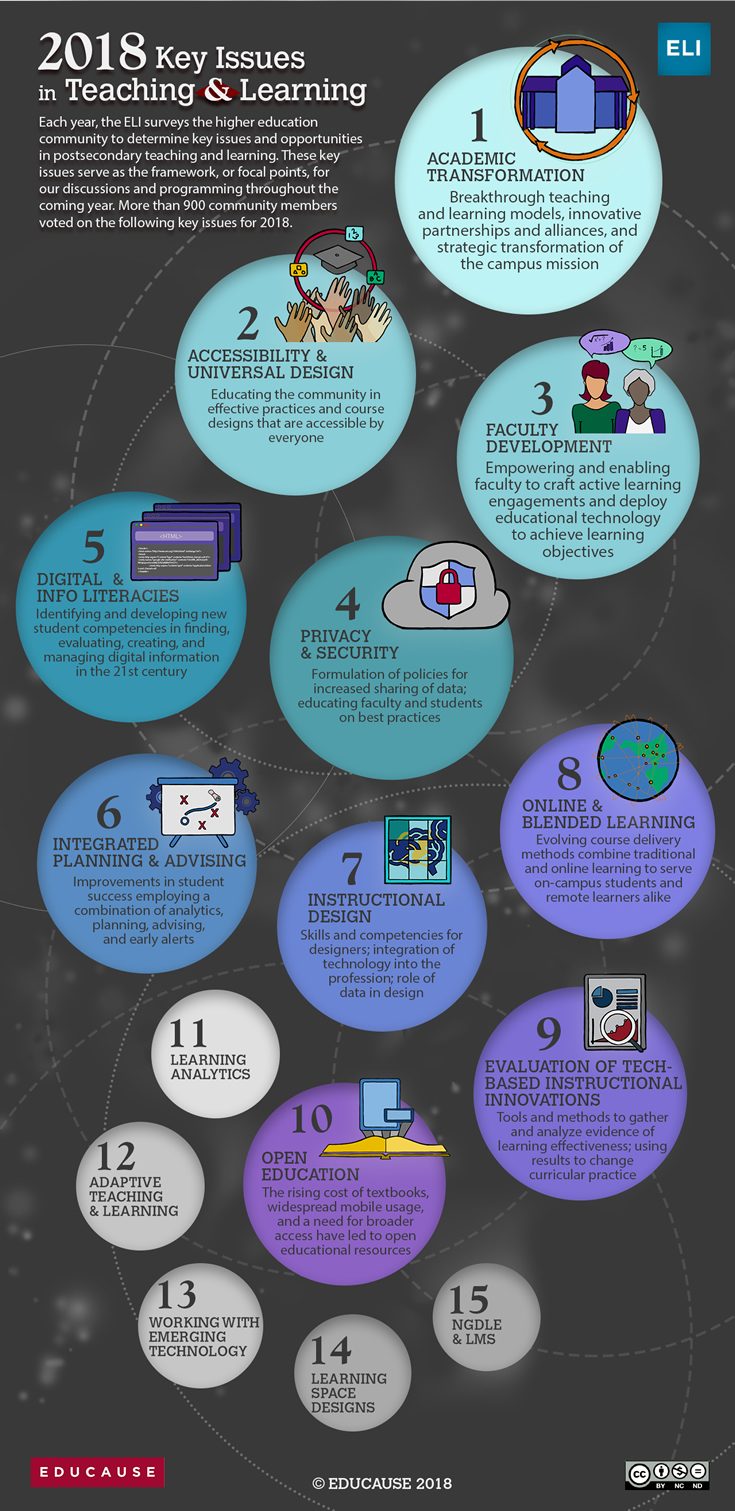
1. Academic Transformation
2. Accessibility and UDL
3. Faculty Development
4. Privacy and Security
5. Digital and Information Literacies
https://cdn.nmc.org/media/2017-nmc-strategic-brief-digital-literacy-in-higher-education-II.pdf
Three Models of Digital Literacy: Universal, Creative, Literacy Across Disciplines
United States digital literacy frameworks tend to focus on educational policy details and personal empowerment, the latter encouraging learners to become more effective students, better creators, smarter information consumers, and more influential members of their community.
National policies are vitally important in European digital literacy work, unsurprising for a continent well populated with nation-states and struggling to redefine itself, while still trying to grow economies in the wake of the 2008 financial crisis and subsequent financial pressures
African digital literacy is more business-oriented.
Middle Eastern nations offer yet another variation, with a strong focus on media literacy. As with other regions, this can be a response to countries with strong state influence or control over local media. It can also represent a drive to produce more locally-sourced content, as opposed to consuming material from abroad, which may elicit criticism of neocolonialism or religious challenges.
p. 14 Digital literacy for Humanities: What does it mean to be digitally literate in history, literature, or philosophy? Creativity in these disciplines often involves textuality, given the large role writing plays in them, as, for example, in the Folger Shakespeare Library’s instructor’s guide. In the digital realm, this can include web-based writing through social media, along with the creation of multimedia projects through posters, presentations, and video. Information literacy remains a key part of digital literacy in the humanities. The digital humanities movement has not seen much connection with digital literacy, unfortunately, but their alignment seems likely, given the turn toward using digital technologies to explore humanities questions. That development could then foster a spread of other technologies and approaches to the rest of the humanities, including mapping, data visualization, text mining, web-based digital archives, and “distant reading” (working with very large bodies of texts). The digital humanities’ emphasis on making projects may also increase
Digital Literacy for Business: Digital literacy in this world is focused on manipulation of data, from spreadsheets to more advanced modeling software, leading up to degrees in management information systems. Management classes unsurprisingly focus on how to organize people working on and with digital tools.
Digital Literacy for Computer Science: Naturally, coding appears as a central competency within this discipline. Other aspects of the digital world feature prominently, including hardware and network architecture. Some courses housed within the computer science discipline offer a deeper examination of the impact of computing on society and politics, along with how to use digital tools. Media production plays a minor role here, beyond publications (posters, videos), as many institutions assign multimedia to other departments. Looking forward to a future when automation has become both more widespread and powerful, developing artificial intelligence projects will potentially play a role in computer science literacy.
6. Integrated Planning and Advising Systems for Student Success (iPASS)
7. Instructional Design
8. Online and Blended Learning
In traditional instruction, students’ first contact with new ideas happens in class, usually through direct instruction from the professor; after exposure to the basics, students are turned out of the classroom to tackle the most difficult tasks in learning — those that involve application, analysis, synthesis, and creativity — in their individual spaces. Flipped learning reverses this, by moving first contact with new concepts to the individual space and using the newly-expanded time in class for students to pursue difficult, higher-level tasks together, with the instructor as a guide.
Let’s take a look at some of the myths about flipped learning and try to find the facts.
Myth: Flipped learning is predicated on recording videos for students to watch before class.
Fact: Flipped learning does not require video. Although many real-life implementations of flipped learning use video, there’s nothing that says video must be used. In fact, one of the earliest instances of flipped learning — Eric Mazur’s peer instruction concept, used in Harvard physics classes — uses no video but rather an online text outfitted with social annotation software. And one of the most successful public instances of flipped learning, an edX course on numerical methods designed by Lorena Barba of George Washington University, uses precisely one video. Video is simply not necessary for flipped learning, and many alternatives to video can lead to effective flipped learning environments [http://rtalbert.org/flipped-learning-without-video/].
Myth: Flipped learning replaces face-to-face teaching.
Fact: Flipped learning optimizes face-to-face teaching. Flipped learning may (but does not always) replace lectures in class, but this is not to say that it replaces teaching. Teaching and “telling” are not the same thing.
Myth: Flipped learning has no evidence to back up its effectiveness.
Fact: Flipped learning research is growing at an exponential pace and has been since at least 2014. That research — 131 peer-reviewed articles in the first half of 2017 alone — includes results from primary, secondary, and postsecondary education in nearly every discipline, most showing significant improvements in student learning, motivation, and critical thinking skills.
Myth: Flipped learning is a fad.
Fact: Flipped learning has been with us in the form defined here for nearly 20 years.
Myth: People have been doing flipped learning for centuries.
Fact: Flipped learning is not just a rebranding of old techniques. The basic concept of students doing individually active work to encounter new ideas that are then built upon in class is almost as old as the university itself. So flipped learning is, in a real sense, a modern means of returning higher education to its roots. Even so, flipped learning is different from these time-honored techniques.
Myth: Students and professors prefer lecture over flipped learning.
Fact: Students and professors embrace flipped learning once they understand the benefits. It’s true that professors often enjoy their lectures, and students often enjoy being lectured to. But the question is not who “enjoys” what, but rather what helps students learn the best.They know what the research says about the effectiveness of active learning
Assertion: Flipped learning provides a platform for implementing active learning in a way that works powerfully for students.
9. Evaluating Technology-based Instructional Innovations

What is the total cost of my innovation, including both new spending and the use of existing resources?
What’s the unit I should measure that connects cost with a change in performance?
How might the expected change in student performance also support a more sustainable financial model?
The Exposure Approach: we don’t provide a way for participants to determine if they learned anything new or now have the confidence or competence to apply what they learned.
The Exemplar Approach: from ‘show and tell’ for adults to show, tell, do and learn.
The Tutorial Approach: Getting a group that can meet at the same time and place can be challenging. That is why many faculty report a preference for self-paced professional development.build in simple self-assessment checks. We can add prompts that invite people to engage in some sort of follow up activity with a colleague. We can also add an elective option for faculty in a tutorial to actually create or do something with what they learned and then submit it for direct or narrative feedback.
The Course Approach: a non-credit format, these have the benefits of a more structured and lengthy learning experience, even if they are just three to five-week short courses that meet online or in-person once every week or two.involve badges, portfolios, peer assessment, self-assessment, or one-on-one feedback from a facilitator
The Academy Approach: like the course approach, is one that tends to be a deeper and more extended experience. People might gather in a cohort over a year or longer.Assessment through coaching and mentoring, the use of portfolios, peer feedback and much more can be easily incorporated to add a rich assessment element to such longer-term professional development programs.
The Mentoring Approach: The mentors often don’t set specific learning goals with the mentee. Instead, it is often a set of structured meetings, but also someone to whom mentees can turn with questions and tips along the way.
The Coaching Approach: A mentor tends to be a broader type of relationship with a person.A coaching relationship tends to be more focused upon specific goals, tasks or outcomes.
The Peer Approach:This can be done on a 1:1 basis or in small groups, where those who are teaching the same courses are able to compare notes on curricula and teaching models. They might give each other feedback on how to teach certain concepts, how to write syllabi, how to handle certain teaching and learning challenges, and much more. Faculty might sit in on each other’s courses, observe, and give feedback afterward.
The Self-Directed Approach:a self-assessment strategy such as setting goals and creating simple checklists and rubrics to monitor our progress. Or, we invite feedback from colleagues, often in a narrative and/or informal format. We might also create a portfolio of our work, or engage in some sort of learning journal that documents our thoughts, experiments, experiences, and learning along the way.
The Buffet Approach:
10. Open Education

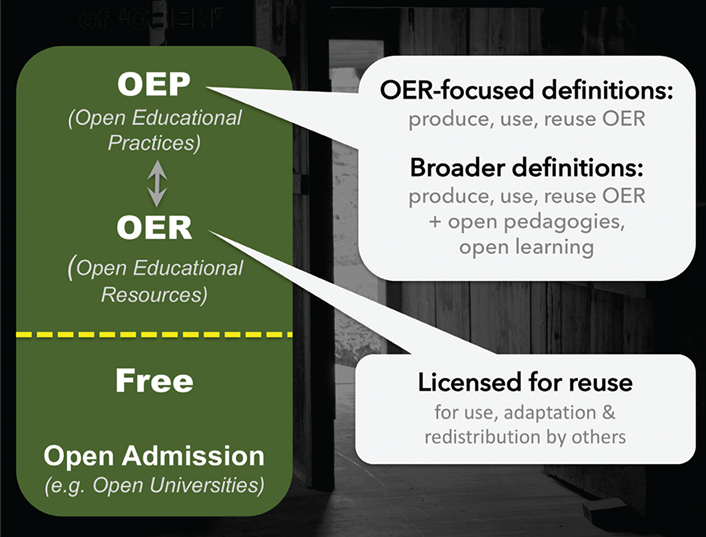
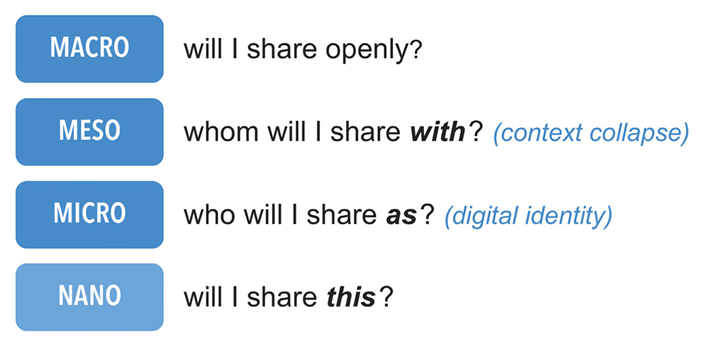
11. Learning Analytics
12. Adaptive Teaching and Learning
13. Working with Emerging Technology
In 2014, administrators at Central Piedmont Community College (CPCC) in Charlotte, North Carolina, began talks with members of the North Carolina State Board of Community Colleges and North Carolina Community College System (NCCCS) leadership about starting a CBE program.
Building on an existing project at CPCC for identifying the elements of a digital learning environment (DLE), which was itself influenced by the EDUCAUSE publication The Next Generation Digital Learning Environment: A Report on Research,1 the committee reached consensus on a DLE concept and a shared lexicon: the “Digital Learning Environment Operational Definitions,
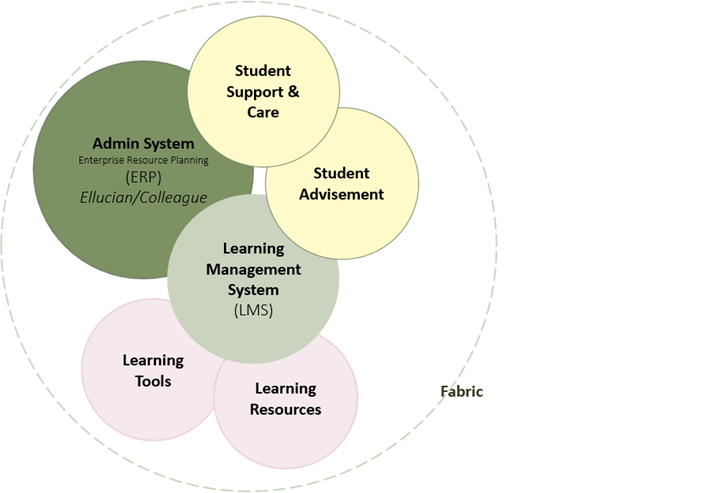
Three Things Teachers Need to Spot—and Stop—Plagiarism
my note: I firmly disagree with the corporate push to mechanize plagiarism. Plagiarism is about teaching both faculty and students, and this industry, under the same cover is trying to make a profit by mechanizing, not teaching about plagiarism.
https://www.edsurge.com/news/2018-10-08-three-things-teachers-need-to-spot-and-stop-plagiarism
According to the International Center for Academic Integrity, 58% of more than 70,000 students surveyed say they have plagiarized someone else’s ideas in their writing.
Plagiarism-detection software can address the most pressing needs of classroom educators faced with assessing students’ written work. Here’s how:
1. Teachers Need More Time
The Challenge: The larger the class is, and the more students that are in it, the longer it takes to review each written assignment—checking grammar, style, originality of ideas, etc. This is especially important when screening for plagiarism.
My note: this is NOT true. If the teacher is still lingering in the old habits of lecturing, this could be true. However, when a teacher gets into the habit of reviewing papers, s/he can detect as soon as in the first several paragraphs the discrepancies due to copy and paste of other work versus the student’s work.
In addition, if the teacher applies group work in her/his class, s/he can organize students to proofread each other’s work, thus teaching them actively about plagiarism, punctuation etc.
2. Evidence Must Be Reliable
The Challenge: When identifying plagiarism, teachers need to be confident in their assessment. Accusing students of academic dishonesty is a weighty claim; it can lead to their suspension or even expulsion from school.
My note: another myth perpetuated by industry searching for profit. Instead of looking at the process of plagiarism as punitive action, an educator will look at it as education and prevention. Prevention of plagiarism will never be successful, if the focus as in this article is on “suspension,” “expulsion,” etc. The goal of the teacher is NOT to catch the student, but to work with the student and understand the complexity of plagiarism.
3. Tools Must Be Easy to Use
My note: right, the goal is to make the teacher think as less as possible.
My note: PlagiarismCheck is the same as TurnitIn and all other tools, which seek profit, not education. Considering that plagiarism is a moving target (https://blog.stcloudstate.edu/ims/2016/01/10/plagiarism-or-collaboration/) and it is a concept first and secondly an action, the attempt to extract profits from the mechanization of this process is no less corrupt then the attempt to focus on profit (of education) rather then on education (itself)
=+++++=========+
more on plagiarism in this IMS blog
https://blog.stcloudstate.edu/ims?s=plagiarism
Mapping 1968, Conflict and Change
An Opportunity for Interdisciplinary Research
When: Friday, September 28, 8:30am-3:00pm
Where: Wilson Research Collaboration Studio, Wilson Library
Cost: Free; advanced registration is required
1968 was one of the most turbulent years of the 20th century. 2018 marks the 50th anniversary of that year’s landmark political, social and cultural events–events that continue to influence our world today.
Focusing on the importance of this 50 year anniversary we are calling out to all faculty, staff, students, and community partners to participate the workshop ‘Mapping 1968, Conflict and Change’. This all-day event is designed to bring people together into working groups based on common themes. Bring your talent and curiosity to apply an interdisciplinary approach to further explore the spatial context of these historic and/or current events. Learn new skills on mapping techniques that can be applied to any time in history. To compliment the expertise that you bring to the workshop, working groups will also have the support of library, mapping, and data science experts to help gather, create, and organize the spatial components of a given topic.
To learn more and to register for the workshop, go here.
Workshop sponsors: Institute for Advanced Studies (IAS), U-Spatial, Liberal Arts Technologies & Innovation Services (LATIS), Digital Arts, Science & Humanities (DASH), and UMN Libraries.
https://www.goodreads.com/book/show/5114403-early-thematic-mapping-in-the-history-of-cartography – symbolization methods, cartographers and statisticians.
Kevin Ehrman-Solberg ehrma046@umn.edu PPT on Mapping Prejudice. https://www.mappingprejudice.org/
Henneping County scanned the deeds, OCR, Python script to search. Data in an open source. covenant data. Local historian found microfishes, the language from the initial data. e.g. eugenics flavor: arian, truncate.
covenance: https://www.dictionary.com/browse/convenance
Dan Milz. Public Affairs. geo-referencing, teaching a class environmental planning, spatial analysis, dmilz@umn.edu @dcmlz
Chris ancient historian. The Tale of Mediterranean, City: Mapping the history of Premodern Carthage and Tunis.
College of Liberal Arts
from archives to special resources. archaeological data into GIS layers. ESRI https://www.esri.com/en-us/home how interactive is ESRI.
mapping for 6 months. finding the maps in the archeological and history reports was time consuming. once that data was sorted out, exciting.
Kate Carlson, U-Spatial Story Maps, An Intro
patters, we wouldn’t see if we did not bring it up spatially. interactivity and data visualization, digital humanities
making an argument, asking questions, crowdsourcing, archival and resources accessibility, civitates orbis terrarum http://historic-cities.huji.ac.il/mapmakers/braun_hogenberg.html
storymaps.arcgis.com/en/gallery https://storymaps.arcgis.com/en/gallery/#s=0 cloud-based mapping software. ArcGIS Online. organizational account for the U, 600 users. over 700 storymaps creates within the U, some of them are not active, share all kind of data: archive data on spreadsheet, but also a whole set of data within the software; so add the data or use the ArcGIS data and use templates. web maps into the storymap app, Living Atlas: curated set of data: hunderd sets of data, from sat images, to different contents. 846 layers of data, imagery, besides org account, one can create maps within the free account with limited access. data browser to use my own data – Data Enrichment to characterized my data. census data from 2018 and before,
make plan, create a storyboard, writing for the web, short and precise (not as writing for a journal), cartographic style, copyright, citing the materials, choosing the right map scale for each page. online learning materials, some only thru org account ESRI academy has course catalogue. Mapping 101, Dekstop GIS 101, Collector 101, Imagery 101, SQL 101, Story Maps 101,
Awards for UMN undergrad and grad students, $1000
history, anthropology, political science,
Melinda, Kernik, Spatial Data Curator kerni016@umn.edu Jenny McBurney jmcburney@umn.edu
z.umn.edu/1968resources https://docs.google.com/presentation/d/1QpdYKA1Rgzd_Nsd4Rr8ed1cJDAX1zeG7J3exRO6BHV0/edit#slide=id.g436145dc5b_0_23
data2.nhgis.org/main
University Digital COnservancy
civil rights information from the U (migrants blog)
DASH Digital Arts, Sciences and Humanities. text mining data visualization,
data repository for the U (DRUM)
DASH director, https://dash.umn.edu/. Ben Wiggins
The “Mapping 1968, Conflict and Change” planning committee is very pleased with the amount of interest and the wonderful attendance at Friday’s gathering. Thank you for attending and actively participating in this interdisciplinary workshop!
To re-cap and learn more on your thoughts and expectations of the workshop we would be grateful if you can take a few moments to complete the
workshop evaluation. Please complete the evaluation even if you were unable to attend last Friday, there are questions regarding continued communication and the possibility for future events of this kind.
Below is a list of presented workshop resources:
Best Regards-
Kate
—
U-Spatial | Spatial Technology Consultant
Research Computing, Office of the Vice President for Research
University of Minnesota
Office Address
Blegen Hall 420
Mailing Address
Geography
Room 414 SocSci
7163A
++++++++++++++
more on GIS in this IMS blog
https://blog.stcloudstate.edu/ims?s=GIS














